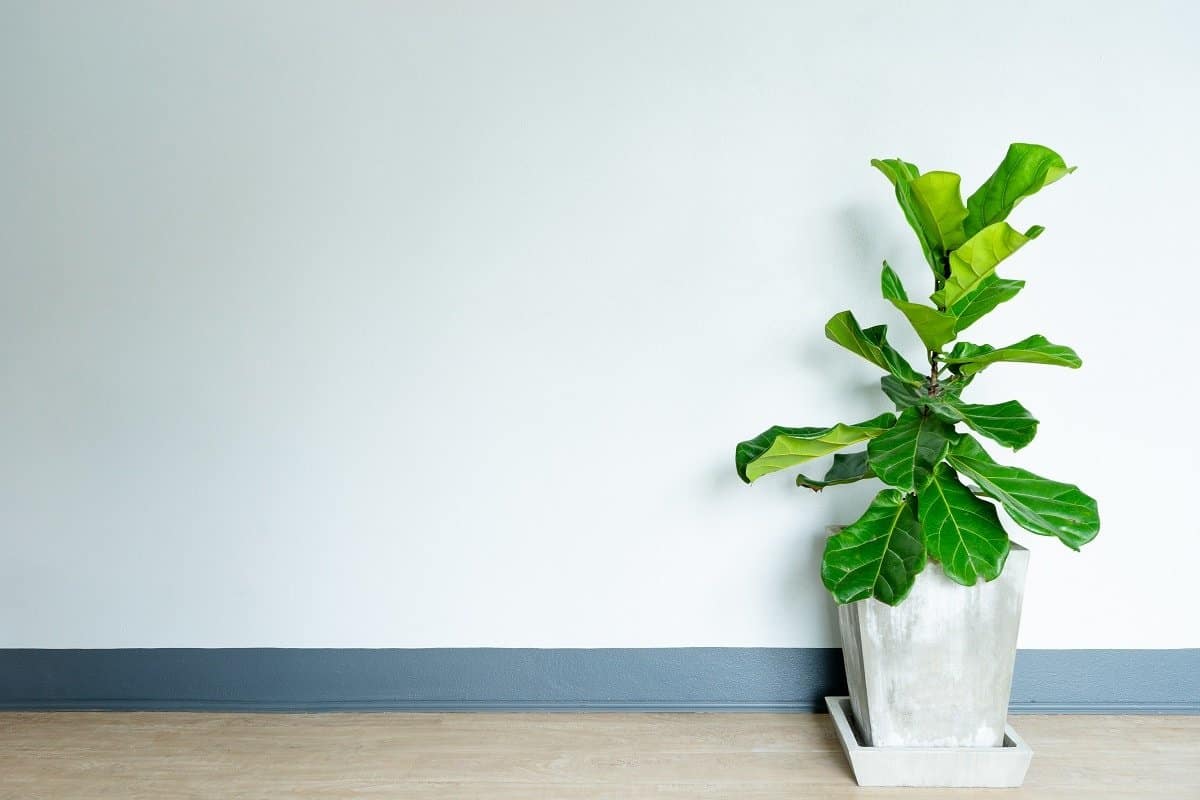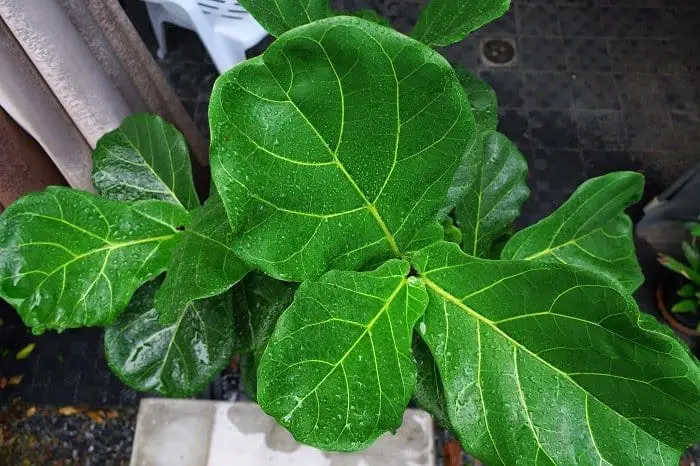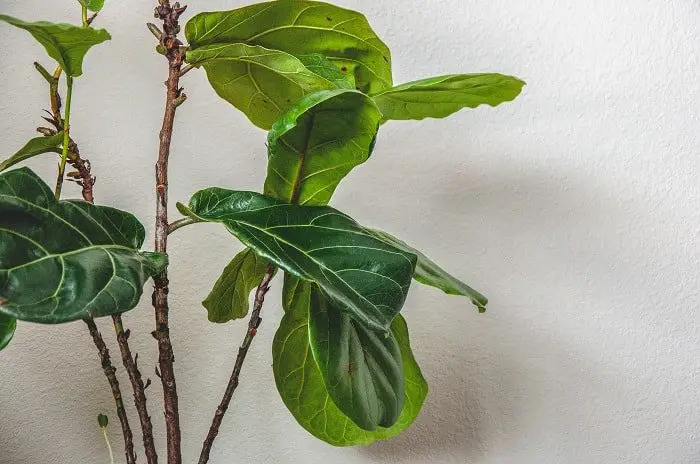Last Updated on January 28, 2023 by Griselda M.
Several gardeners often ask, can I put my fiddle leaf fig outside? The simple answer is, of course, you can, because these plants thrive in the outdoors. Having plants in your home or garden can add a beautiful touch and brighten up your living space or yard. One of the most beautiful plants you can add in this case is the Ficus Lyrata, commonly known as the Fiddle Leaf Fig plant.
However, implementing the proper Ficus Lyrata care when growing them outside is essential if you want to keep them healthy and happy. This is because, with the proper care, this plant usually thrives outdoors. Thanks to its stunning green leaves, the fiddle-leaf fig tree has become a popular choice for many plant enthusiasts. Though it may not be the easiest plant to take care of, once you know what to do, you can successfully maintain it.
These sun-loving plants require gradual movement, especially if you’re transferring them from an indoor environment into the outdoor garden. This transplant has specific requirements which include refreshed soil and the gradual introduction into a new environment. Let’s take a look below at how it’s done.
Full Grown Fiddle Leaf Fig Outdoors – Care and Maintenance
A full-grown fiddle leaf fig outdoors is a rare find. Seeing that you’ve asked the question, can I put my fiddle leaf fig outside, we obliged and decided to answer it to the best of our knowledge. These plants are mostly kept as houseplants; however, the desire from some gardeners to grow them outside for landscape enhancement purposes is plenty. The key to growing them successfully outside is to implement care and maintenance strategies that would prove fruitful.
Whether you choose to grow them in an outdoor plant pot or on the ground, take heed of the following care and maintenance tips to keep your fiddle leaf fig thriving.
Fiddle Leaf Fig Tree Native Environment
The fiddle leaf fig plant is native to the tropical region of West Africa. This means that the more your climate mimics the West African tropics, the better chance you have of a thriving plant. Keep in mind that just like all plants, the fiddle leaf fig tree is also inclined to its natural environment to reach its full potential. This should include a humid and warm atmosphere with suitable temperatures.
Humidity levels that reach a high of 60% or so would also prove beneficial when growing these plants outdoors. Ideally, if the temperatures and humidity levels are on par, these glorious plants grow well in full sun or partial shade. Therefore, knowing how to recreate the ideal outdoor environment for your Ficus Lyrata is recommended.
USDA Plant Hardiness Zones for Fiddle Leaf Fig Plants
USDA plant hardiness zones 9 through 11 are ideal for growing fiddle-leaf fig trees. These include the majority of regions in the California and Florida areas and certain places in Arizona, Louisiana, and Southern Texas. The reason that these areas are ideal is that they have the recommended humidity and temperature levels that suit these plants. However, in times when there is unpredicted occasional dry or cold weather, a little extra care and maintenance are recommended.
Outdoor Temperature Recommendations for Fiddle Leaf Fig Trees
As a part of their care and maintenance plan, temperatures between 55 and 85 F would prove ideal for growing these plants in an outdoor environment. However; keep in mind that this is the extreme that fiddle leaf fig trees can tolerate as together with these temperatures, you should also look at other environmental factors that can contribute to flawing your plant’s growth. Keep in mind that very high heat that directly hits your plant can burn its foliage so in high temperatures, indirect sunlight would be best.
Winter Care for Your Fiddle Leaf Fig Plant Outdoors
USDA Zones 9-11 do not always experience harsh winters so growing a fiddle-leaf fig tree during the cold season should be much of a problem if you live in these areas. However, in the unusual case that there is a cold rush in these zones, you would be advised to afford your plant’s extra protection to keep them thriving. For this reason, you must monitor the temperatures during the winter season.
If your outdoor fiddles are planted in pots, then it is best to bring them inside when the temperature drops below 50 F during the night time. This will prevent your plant from freezing. A fiddle tree that is planted in the ground would require a little more work. You can opt to lay a protective plastic covering over your plant if it’s still small. However, larger trees are most prone to drops in temperatures and are usually hardy enough to weather the storm compared to saplings.
However, that does not mean the mature trees should be left unattended. Giving them timeous feeds of water and the addition of nutrients will keep them growing strong. In turn, your fiddle leaf fig tree will have ample resources to sail through the change in weather conditions.
Fiddle Leaf Fig Tree Soil Recommendations for Outdoors
Before planting your fiddle leaf fig outdoors, ensure that you have knowledge of the type of soil in your garden. Therefore, testing the growing medium with a DIY soil testing kit is important in this instance. The ideal soil recommendation to grow your plant outdoors is loamy soil that is nutrient-rich and has additions of organic matter, sand, and clay for excellent balance.
One of the most important parts of growing garden plants is to find out the answer to the main question which is, can I put my fiddle leaf fig outside? Although we know that you can, ensuring that you are using the best-growing medium is important to your plant’s health and growth. If you are opting to move your potted fig plant outdoors, then soil with fast-draining properties is highly recommended.
Indoor Ficus Lyrata Care
Just like outdoor care, indoor Ficus Lyrata care is just as important. We now know that the Fiddle Leaf Fig is a species of fig tree that is native to rainforests in central and western African regions. It does best in a warm, humid environment where it can receive lots of direct or indirect light depending on the temperature and should be watered regularly to keep it healthy.
Over the last few years, these plants have gained popularity as house plants, with many people choosing to grow them in their homes. This stunning statement piece can grow to be at least six feet tall or larger depending on the care and maintenance it is afforded. Though you don’t have to be an expert to grow one indoors, it is important to understand the proper care they need to be healthy.
1. Find The Perfect Spot in Your Home
Location is key to a happy Ficus Lyrata in your home. Since they do not like drafts, it is best to choose an area that is not near a doorway, vent, or drafty window when growing them indoors. It is also important to make sure to have your Fiddle Leaf Fig in an area with lots of bright, indirect sunlight.
You do not want to place your plant where the sun will touch it directly if you live in a region that experiences very high temperatures. Rather, you should have it just out of the light, in a bright area. Once you find the perfect spot for your fiddle leaf fig tree, don’t move it, as keeping it in one spot will allow it to flourish.
2. Take Care of the Ficus Lyrata Leaves
The Fiddle Leaf Fig is famous for its large, beautiful green leaves. These special leaves need to be cleaned regularly to keep them healthy. Additionally, for the tree to grow its best and reach its full potential regular maintenance of the plant leaves is highly recommended.
To do this, you should gently wipe the leaves down with a damp washcloth at least once a month. Contrary to popular belief, using coconut oil isn’t the best option to do this, as it is too heavy for the leaves. Wiping the leaves off regularly will get rid of dust mites, fungus growth, and other unwanted pests.
3. Manage the Humidity
Fiddle Leaf Figs need to have high humidity to thrive. A dry house can be really damaging to your plant in this case. The ideal humidity for an indoor Fiddle Leaf Fig tree is between 30-65% to keep it flourishing.
Most houses have humidity levels of around 40%, which is fitting for the plant. However, if your environment is on the drier side, you can use a humidifier or mist your plant weekly to keep the moisture up.
4. Don’t Re-pot Right Away
Your Fiddle Leaf Fig Plant will do just fine in the pot you bought it in when you first get it. If you want, you may put the potted tree inside a decorative pot while still keeping it in its original container.
5. Water Your Plant Sparingly
One of the most damaging things you can do to your fiddle leaf fig tree is to overwater it or not provide a proper draining layer. A Ficus Lyrata plant only needs to be watered every seven to ten days. When watering, the soil should be soaked until dripping, ensuring that the plant pot has sufficient drainage holes to get rid of excess water.
You can either set up a drip tray underneath your plant to catch the excess water or water it outside and let it sit for 1-2 hours before bringing it back in. Keep in mind that you should allow the soil to completely dry before watering it again.
6. Fertilize Your Plant
Your Fiddle Leaf Fig plant should be fertilized once a month in the spring or summertime. The fertilizer you use should have a ratio of 3:1:2 of nitrogen-phosphorus-potassium. You can mix the fertilizer into a watering container based on the fertilizing instructions.
7. Trim Leaves as Needed
To keep your plant healthy, you should trim the leaves if they start to brown. You should use sharp shears to trim rotting or dead leaves at about half an inch at the stem, cutting them back at an angle. However, be sure not to trim more than 5-10 leaves at a time.
You can also style your tree as you like, with either full leaves or a more sparse look. Trimming rotting leaves is important, as it encourages healthy new growth.
8. Repot When Needed
If you want to know when to repot fiddle leaf fig, then the following information would be helpful. When your plant starts to grow too large for its pot, for example when the roots begin to grow out of the drainage holes, it is time to re-pot. You should choose a pot with drainage holes that is about two inches larger than the plant container your fiddle leaf fig tree is currently in.
Before transferring, add a layer of rocks to the bottom of your new pot that is about 2-3 inches deep. Carefully remove the root ball from the old pot and remove any rotten or damaged roots before transplanting. Then, add the plant to the larger pot with fresh soil. Top it up, leaving at least an inch at the top for watering purposes.
Fiddle Leaf Fig plants typically need to be repotted every 18-24 months. At some point, your plant may outgrow an indoor environment and would need to be moved outdoors. That is why we thought it essential to answer the question, can I put my fiddle leaf fig outside? Just remember that these plants need lots of care and maintenance as they can grow quite tall.
A Wonderful Addition to Your House and Garden
So, we have answered the pressing question, can I put my fiddle leaf fig outside? The thing is, as long as you know how to care for your Ficus Lyrata tree, it can be a wonderful addition to any interior or exterior space as it lends a beautiful look to any environment. These plants have a stunning, unique look to enhance any garden or landscape even though they are mostly grown indoors. Their beautiful large green leaves stand out and with the proper care, they are sure to reach their full potential.
FAQs
How often do you water a ficus Lyrata?
The average plant needs water approximately three-times per week. For example, ficus Lyrata plants can thrive in soil that has been watered two-times per week and still remain healthy. They will also appreciate having their soil moistened once a day, every day during the summer months when they are growing faster than they would at other times of the year.
Should I cut off brown leaves on fiddle leaf fig?
Some people might think that brown leaves are normal on a fiddle leaf fig plant and should be left on the plant. However, these brown leaves can also prevent other new growth from coming in through the soil. This means that they should be removed if you want your fiddle leaf fig to grow well and get new leaves.
How do I know if my fiddle Leaf needs water?
You can tell if your Fiddle Leaf Plant needs water by checking the soil. If it's fully dry and you feel that there is no more moisture, then you should give it more water.
Where do you put fiddle leaf figs indoors?
Fiddle leaf figs are a type of plant that can be grown indoors in certain areas. They are not too picky about the location of the room, but they need good sunlight in order to grow.
It is important to place them near windows for enough sunlight. If they do not get enough light, their leaves will turn brown and crispy. Blooming figs like more sun than non-blooming figs, so make sure they get at least 6 hours of light.
Can I keep a Fiddle Leaf Fig outside?
It is absolutely possible to keep a Fiddle Leaf Fig outside. Fiddle Leaf Fig trees can survive in most climates and we need to know how to care for them properly if we want to keep them healthy and happy.
The first thing that you need to do is plant your tree in a pot that is slightly bigger than the root ball. Fill the pot with soil mixed with compost, perlite, or pebbles, whichever works best for your environment. The second thing you need to do is water your tree daily in order for it to stay hydrated. Lastly, make sure that you are placing it in an area where it will get plenty of sunlight - about 6 hours a day at least.
What temperature do fiddle leaf figs like?
A fiddle leaf fig is a large, tropical plant with leaves shaped like an open violin. Fiddle leaf figs are not native to the United States, so you cannot find them at your local nursery or garden center. You can buy fiddle leaf figs online or through other retailers that specialize in tropical plants.
The leaves of the fiddle leaf fig plant are sensitive to temperature and humidity levels. They will not thrive if exposed to temperatures below 55 degrees Fahrenheit because it will cause the leaves to drop prematurely. The ideal temperature for a healthy fiddle leaf fig plant is between 70 degrees and 80 degrees Fahrenheit during the day and 60 degrees at night.
Why is my fiddle leaf not growing new leaves?
The most common causes of leaf drop are various problems with the plant such as lack of moisture, insufficient light, pest infestation, and disease. Leaf drop is usually not a sign that the plant is dying.
Fiddle leaf figs usually don't grow new leaves unless they are repotted or moved to a new pot with fresh soil and new lighting conditions.
Tony Manhart is a passionate gardener who has been tending to gardens for over 20 years. He takes pride in creating beautiful outdoor spaces with plants, trees, and shrubs that can thrive in any environment. He loves to share his knowledge with others and has taught classes on gardening basics and advanced techniques. He is committed to sustainability, using natural and organic methods to create and maintain gardens. He also works with local organizations to create green spaces for communities. When he’s not gardening, Tony enjoys hiking, reading, and spending time with his family.




